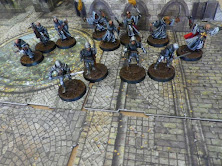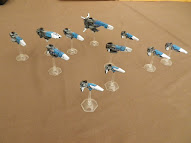PROBLEM #1: ACTIVATION
I've laid out my aims here. The aim is for somewhat unpredictable activation, with better pilots, undetected planes and higher energy giving an advantage.
A commentator laid out some of my issues:
1. Pairs of planes.
2. Limited coordination. (aka. somewhat random - no overarching planning ahead/grand strategy allowed)
3. Aces have a situational advantage. (I'd add + energy & detection also should factor in)
Now, for a bit of background: I'm almost certainly using a 1.5APT (1 automatic action plus 50% or so pilot roll/chance of a 2nd action) method, i.e. jets can move for free and make 1 90d turn, but need it's 'action' to perform a special maneuver (Immelman, yoyo, etc) or lock+shoot which shows the extra concentration needed in combat. This represents that the pilot can still fly the plane even when flustered, but may not be able to coolly line up shots, and only very good pilots can consistently roll a second action and thus reliably combine complex maneuvers and shooting...
I think I can easily solve the pairs of planes aka wingman concept, but the overall method for move order still bothers me.
Here's some example activation/move order methods and why/why not I'd use them.
Bolt Action. One dice per unit. Pull dice out of a box. If it's your dice, choose a unit to act.
Good: It's random. Perhaps too random. It's easy.
Bad: It favours the side with more units, not better energy, detection or skills.
1/5 stars
Modified Bolt Action. Pull a dice randomly out of a box like above. If it's your dice, roll it.You can act on 3+ (d6), +/- 1 high or low energy, +1 undetected, -1 tailed, +/-1 good/bad crew. If you fail the roll, you move straight ahead or lose an action or some penalty.
Good: Mix of randomness and energy/skill/detection. Outnumbering is not as impactful. It's not too predictable.
Bad: No one will enjoy failing the roll. Maybe just can either turn or fire OR... passing the roll gives you an EXTRA action<-it's all how you spin it!
3/5 stars
LoTR. Side A moves. Side B moves. Side A shoots. Side C shoots.
Good: It breaks the turn up a bit. It's very simple.
Bad: It isn't random. It ignores energy, detection and pilot skill.
Note: you could combine LoTR with "better pilot" below
1/5 stars
Better energy/better pilot first (X-Wing). Move in order of most/least energy or best/worst pilot. (Whatever you choose, use the other one to break ties)
Good: It's consistent and factors in skill/energy. Very simple. But you have to ignore one factor (i.e. detection). Maybe... undetected planes move in their own phase using the same sequence?
Bad: It isn't random, you can see the exact move order before you start activating units
3/5 stars
Card based (Bag the Hun). Each unit is assigned to a card, they act when the card it pulled. You could add in extra cards for aces, the unit with the highest energy or undetected units.
Good: It's random but not completely random (you can add in some limited nod to energy/ace/detection). It's not predictable.
Bad: I'm not a fan of cards and tracking who is what card, or the gaminess of a special 'ace' or 'high energy' card.
2/5 stars
--OK, now for some I'm seriously considering--
Modified D6. Each unit rolls a d6. +/-1 high low energy, +1 undetected, -1 tailed. Max is 6, minimum is 1. Better pilots break ties.
Good: It considers detection, skill and energy AND is random-ish. Not too complex.
Bad: You'd have a micro dice sitting on the table next to the plane until it acts. And I'm trying to remove clutter so much I abstracted altitude FFS. It's only slightly better than 'better energy first' as you'd still be able to see what order things would happen in before the round starts.
4/5 stars
Opposed Roll D10 (Infinity). Player with initiative at start of gamer nominates a model. If the opponent has models in detection arc, they roll an opposed roll with modifiers like
-2 enemy in rear 180
+/- Better pilot
+/- Better radar
+/-2 High/low energy
The winner can act OR choose to have the loser act. Then he chooses another unit to duel.
Good: You can mix detection in with activation and consider angles etc. Gives a feeling of a 'duel' between pilots. Initiative can swap at any time, unexpectedly.
Bad: It's more complicated - what do you do if you pick a model and there's no one detecting you? (Pass a simple target number to retain initiative?) What happens when one unit has models left over after the other has activated? (penalty to actions of leftover units - so having more planes/going last isn't too OP?)
4/5 stars
PROBLEM #2: INTEGRATING DETECTION ("TRACKING")
It's not submarine-like detection 'stealth' so much as 'tracking' i.e. not losing sight of an enemy jet at a vital moment. I was hoping could combine it with activation and enemy lock on to remove an extra phase.
So far it looks like
#1. Roll to find move order (any method above)
#2. Roll to see how many actions (1 or 2) based on skill etc (this could be combined with #1)
#3. Roll to track enemy <- this is a detection roll
#4. Roll to hit missiles / resolve dogfights
#6. Resolve damage
While this isn't worse than Necromunda or Kill Team (level of detail I'm aiming for), I'd like to streamline where possible. So rather than detection #3 being it's own thing, I might see if I can shift its effects into
#1 (untracked = a bonus to initiative/activation) and #4 (untracked = bonus to missile hits or dogfights) could be combined with #3 somehow.
Buuuut - how do I determine who is tracked or not without a separate roll?
Better radar/AoA could be bonus to the move order/activation I guess - but how does that tell me if they are tracked or not? Maybe if opponent fails a TN they are untracked? (See Opposed Roll method above)
I.e. Plane A has stat 5 + rolls 7 = 12. He wins and beats Plane B who is stat 4 but rolls a 4 = 8. Now Plane A goes first AND remains untracked as Plane B missed a target number (say 10?) however if Plane B rolled a 6 and got a 10 total (loses but equals or beats the target number), Plane A still goes first but is tracked by Plane B....
Perhaps I am overthinking things and should simply roll an extra detection roll. I mean, most games would... I could move the detection roll BEFORE #1 (say as a #0) so both players could be making detection rolls simultaneously (speeds up play) and THEN actions and initiative occur AFTER detection is resolved...



















